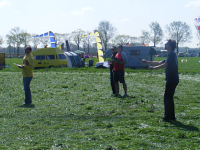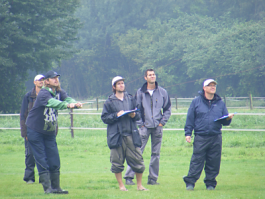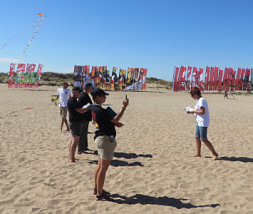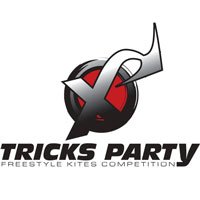Judging: The Basics
 When judging a competition, you need to know a few things besides all the tricks. You don't have to be able to do all the tricks, but you must know what they should look like and how they are performed. Websites like this will be a great help, as you have each trick in four different ways explained (definition, key elements, judges view, most common errors). Practice makes perfect, so use whatever opportunity you have to judge tricks and ballets. Most of it will be videos, that's ok. But you need to get out and judge pilots doing single tricks or ballets. The view out there gives you information about the wind window, the movement of the pilot, the position of the kite in the wind window. Things you hardly notice in a video ;-)
When judging a competition, you need to know a few things besides all the tricks. You don't have to be able to do all the tricks, but you must know what they should look like and how they are performed. Websites like this will be a great help, as you have each trick in four different ways explained (definition, key elements, judges view, most common errors). Practice makes perfect, so use whatever opportunity you have to judge tricks and ballets. Most of it will be videos, that's ok. But you need to get out and judge pilots doing single tricks or ballets. The view out there gives you information about the wind window, the movement of the pilot, the position of the kite in the wind window. Things you hardly notice in a video ;-)
Prejudice is not a good thing, you should judge with an open mind towards what's happening with the kite. It doesn't matter if the pilot is a cute 8 year old boy, a 20 year old female, a world champion or a 65 year old veteran. It doesn't matter if you like the colors of the kite, the shape of the kite or the builder/inventor of that model. It doesn't matter if you are a big fan of the music the pilot is flying to or if you hate to hear that tune over and over again. It doesn't matter if there is no wind, or if the wind blows 34 km/hour. All you are concerned with is what you see the kite is doing. It sounds logical, but it isn't at times. It's best to be honest with yourself and try to be the fairest judge you can be. So if you feel after two pilots that you are scoring too high (or low), don't change what you have given, but maintain the same level for all the pilots to come. In the end that's the best way to deal with having an "off day". It can be helpfull to see video's of the competition afterwards and compare what score you gave with what you see on the screen. Because on the competition field, you only have the moment itself to judge what you just have seen, there's no rewind button, no repeat system ;-) Don't feel bad if you miss a few things during your first competitions. It takes a competition or 3 before you get the hang of it, before you learn how to stay focused and build yourself a system to fall back on. Therefore, it is common to do some competitions judging as a "shadow judge". You then just do the same as the ordinary judges, just that your score does not count for the outcome. You can then (if time permits) discuss it with the judges and see how your score compared to that of them.
 We started with competitions way back in 2003, and ever since that day we tried to improve the way we judged to make certain every pilot had the same chance to score well. Judging together with the likes of Harold Slit and Henri Nijenhuis was a good way to learn each competition how to look at certain tricks. The result of that can be found in the Judges View and Most Common Errors. A couple of years we had German judges at the competitions held in Lommel (with more than 30 pilots!) and for some years we had lovely Jolien Coenraets to help us out at judging. The foundation was laid out in the South of France, the experience gained was in The Netherlands and Belgium. Too bad that there was no source for judges (new and old) to check up on their skills or get trained at the basics. So that's what this website is all about: trying to share the experience and hopefully get some fair judges along the way.
We started with competitions way back in 2003, and ever since that day we tried to improve the way we judged to make certain every pilot had the same chance to score well. Judging together with the likes of Harold Slit and Henri Nijenhuis was a good way to learn each competition how to look at certain tricks. The result of that can be found in the Judges View and Most Common Errors. A couple of years we had German judges at the competitions held in Lommel (with more than 30 pilots!) and for some years we had lovely Jolien Coenraets to help us out at judging. The foundation was laid out in the South of France, the experience gained was in The Netherlands and Belgium. Too bad that there was no source for judges (new and old) to check up on their skills or get trained at the basics. So that's what this website is all about: trying to share the experience and hopefully get some fair judges along the way.
What do you need on the field to judge? It is a good idea to have double protection against the sunlight: get some sunblock to protect your skin against the sunrays. You will look like a lobster or tomato if you don't. Certainly your neck and the back of your legs (if wearing shorts). Secondly your eyes need to be protected, sunglasses and/or a cap to keep your vision out of the sun will help a lot to keep a clear vision on the kites! The organizer will provide you with writing boards and a pen, be sure to have a back-up pen close by. Murphy's law will strike when you least expe ct it! And most of all: keep smiling and have fun! By the way: when it's hot, make sure the organizer provides you with cool water and a pauze now and then. Concentration must be the same all the competition, and you can't do that if you dry out or get tired. As a rule, I would say that when it's hot, 10 pilots are the maximum, then take a break. Otherwise, 15 is more than enough to justify a break. Concentration drops and that is not fair for those pilots up front (they get judged 'harder').
ct it! And most of all: keep smiling and have fun! By the way: when it's hot, make sure the organizer provides you with cool water and a pauze now and then. Concentration must be the same all the competition, and you can't do that if you dry out or get tired. As a rule, I would say that when it's hot, 10 pilots are the maximum, then take a break. Otherwise, 15 is more than enough to justify a break. Concentration drops and that is not fair for those pilots up front (they get judged 'harder').
